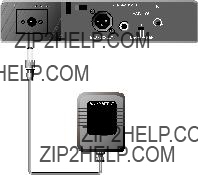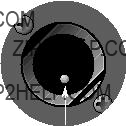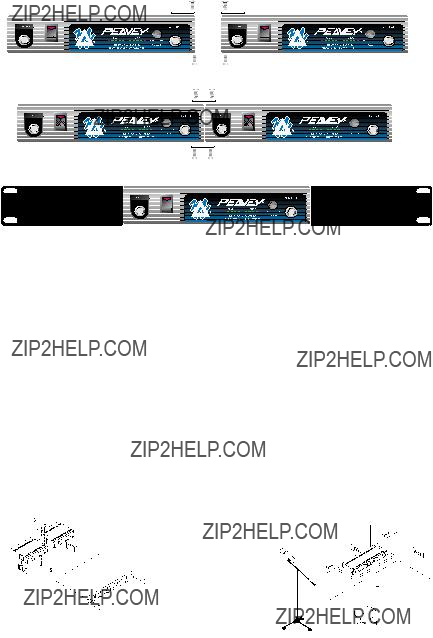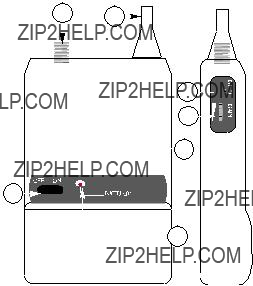
P
C
X
-
V 1 2
True diversityi i
VHF wirelessi l receiveri
O P E R A T I N G G U I D E

P
C
X
-
V 1 2
True diversityi i
VHF wirelessi l receiveri
O P E R A T I N G G U I D E

Intended to alert the user to the presence of uninsulated ???dangerous voltage??? within the product???s enclosure that may be of sufficient magnitude to constitute a risk of electric shock to persons.
Intended to alert the user of the presence of important operating and maintenance (servicing) instructions in the literature accompanying the product.
CAUTION: Risk of electrical shock ??? DO NOT OPEN!
CAUTION: To reduce the risk of electric shock, do not remove cover. No user serviceable parts inside. Refer servicing to qualified service personnel.
WARNING: To prevent electrical shock or fire hazard, do not expose this appliance to rain or moisture. Before using this appliance, read the operating guide for further warnings.
Este s??mbolo tiene el prop??sito, de alertar al usuario de la presencia de ???(voltaje) peligroso??? sin aislamiento dentro de la caja del producto y que puede tener una magnitud suficiente como para constituir riesgo de descarga el??ctrica.
Este s??mbolo tiene el prop??sito de alertar al usario de la presencia de instruccones importantes sobre la operaci??n y mantenimiento en la informaci??n que viene con el producto.
PRECAUCION: Riesgo de descarga el??ctrica ??NO ABRIR!
PRECAUCION: Para disminu??r el riesgo de descarga el??ctrica, no abra la cubierta. No hay piezas ??tiles dentro. Deje todo mantenimiento en manos del personal t??cnico cualifi- cado.
ADVERTENCIA: Para evitar descargas el??ctricas o peligro de incendio, no deje expuesto a la lluvia o humedad este aparato Antes de usar este aparato, Iea m??s advertencias en la gu??a de operaci??n.
Ce symbole est utilis?? dans ce manuel pour indiquer ?? l???utilisateur la pr??sence d???une tension dangereuse pouvant ??tre d???amplitude suffisante pour constituer un risque de choc ??lectrique.
Ce symbole est utilis?? dans ce manuel pour indiquer ?? l???utilisateur qu???il ou qu???elle trouvera d???importantes instructions concernant l???utilisation et l???entretien de l???appareil dans le paragraphe signal??.
ATTENTION: Risques de choc ??lectrique ??? NE PAS OUVRIR!
ATTENTION: Afin de r??duire le risque de choc ??lectrique, ne pas enlever le couvercle. Il ne se trouve ?? l???int??rieur aucune pi??ce pouvant ??tre repar??e par l???utilisateur. Confiez I???entretien et la r??paration de l???appareil ?? un r??parateur Peavey agr????.
AVERTISSEMENT: Afin de pr??venir les risques de d??charge ??lectrique ou de feu, n???exposez pas cet appareil ?? la pluie ou ?? l???humidit??. Avant d???utiliser cet appareil, lisez attentivement les avertissements suppl??mentaires de ce manuel.
Dieses Symbol soll den Anwender vor unisolierten gef??hrlichen Spannungen inner- halb des Geh??uses warnen, die von Ausreichender St??rke sind, um einen elek- trischen Schlag verursachen zu k??nnen.
Dieses Symbol soll den Benutzer auf wichtige Instruktionen in der Bedienungsanleitung aufmerksam machen, die Handhabung und Wartung des
Produkts betreffen.
VORSICHT: Risiko ??? Elektrischer Schlag! Nicht ??ffnen!
VORSICHT: Um das Risiko eines elektrischen Schlages zu vermeiden, nicht die Abdeckung enfernen. Es befinden sich keine Teile darin, die vom Anwender repariert werden k??nnten. Reparaturen nur von qualifiziertem Fachpersonal durchf??hren lassen.
ACHTUNG: Um einen elektrischen Schlag oder Feuergefahr zu vermeiden, sollte dieses Ger??t nicht dem Regen oder Feuchtigkeit ausgesetzt werden. Vor Inbetriebnahme unbedingt die Bedienungsanleitung lesen.
2

INTRODUCTION
Thank you for selecting a Peavey Pro Comm PCX- V12 quartz controlled single channel true diversity wireless microphone system. Before operating and installing this system please read this instruction manual carefully and thoroughly in order to attain the correct operating procedures and to achieve the best results.
True Diversity Receiver
The Peavey Pro Comm
This system includes the following accessories:
???AC/DC Adapter
???Mic Clip
???Antenna (2)
???Instruction Manual
1.UNIT FEATURES AND FUNCTIONS
A.Front Panel
Figure 1
3

1.Antenna Input Connector A
2.Power Switch and Indicator:
When the switch is turned on the red indicator illuminates to denote normal power status.
3.RF Signal Level Indicator:
Indicates the RF signal strength received from the microphone. As soon as the signal is emitted from the microphone the LED indicator illuminates.
4.Audio Signal Level Indicator:
Indicates the audio signal level. As soon as the microphone signal is modulated, the LED indicator illuminates.
5.Volume Control:
Adjusts the AF output level of the receiver.
6.Antenna Input Connector B
B.Rear Panel
Figure 2
4

7.DC 12V Input Jack:
Connect the 12V DC plug from the AC/DC adapter.
8.Balanced Audio Output Jack:
XLR type connector
9.Unbalanced Audio Output Jack:
1/4" Phone Jack
10.Unbalanced Level Switch:
???LOW selection is for
11.Squelch Adjustment:
Adjust the squelch level to eliminate the RF noise interference at the receiver.
2.INSTALLATION OF THE RECEIVER
1.Install one of the antennas at the antenna input connector A. Then install the other antenna at the antenna input connector B.
2.AC/DC Power Connection:
Figure 3
Connect the AC/DC adapter cable to the DC 12V input jack. Then plug the adapter unit into an appropriate AC outlet as shown in Figure 3. Caution: Make sure the correct voltage is present at the AC outlet as indicated on the AC/DC adapter.
5

3.Audio Output Connection:
a.Unbalanced Level Switch Setting Position:
Make sure to match the unbalanced output setting to the device input setting. The incorrect setting could result in low sensitivity level or over load distortion. Ex. (If you are going into the ???Line??? input on a mixer or amplifier then the switch should be set to the high position. If you are going into the ???Mic??? input of an amplifier or mixer then the switch should be set to the low position.)
b.Unbalanced Output:
Connect the 1/4" phone plug of the audio cable into the unbalanced output connector on the back of the receiver. Connect the other end of the cable to the proper input of the desired device. Make sure the unbalanced level switch is in the proper position before applying power.
c.Balanced Output:
Connect the male XLR connector into the balanced output connector on the back of the receiver. Connect the other end of the cable into the ???Mic/Balanced??? input of the desired device. The characteristics of the
GND PIN 1 


 PIN 2
PIN 2
 PIN 3
PIN 3
Figure 4
6

3.TWO
1.Push the rack mount brackets
Figure 5
B.Setup for dual
1.Remove the screws at the top and bottom of the receiver where they will be joined together. Remove one steel plate from each receiver. Push the receivers next to each other. Refer to Figure 6.
2.Insert the steel plate in between the two receivers (top and bottom). Align and fasten the screws tightly as shown in Figure 6.
3.Align and fasten the rack mount
7

brackets
Figure 6
4.After completion, it can be rackmounted into an EIA standard rack case. Shown in Figure 7.
5.Make sure that the system performs correctly by placing the system away from noise sources. Place the receiver at least one meter above the ground and one meter away from noise sources. Place the microphone at least one meter away from the receiving antenna, as shown in Figure 8.
8

4.OPERATION INSTRUCTIONS
1.Turn the volume controls of the receiver and device in use to a minimum setting before turning on the microphone transmitter. After the receivers power switch is set to the on position, the power switch???s red indicator illuminates to denote normal power status.
2.If the SIGNAL LED indicators of the receiver are illuminated before switching on the microphone or transmitter, it indicates the receiver is receiving interference signals. The more LEDs that illuminate the more severity of interference. This system has ???Pilotone??? and ???NoiseLock???
squelch controls it affects the sensitivity level of the receiver, therefore, shortening the operating distance and decreasing the stability.
Figure 9
3.Under normal circumstances, the SIGNAL indicator lights up when a microphone or transmitter is turned on near the receiver to indicate the receiver is ready for normal operation. Once sounds enter into the
9
microphone the AUDIO LED indicators will illuminate according to the strength of sound level. If the LEDs do not illuminate or sound is not present at the output, the system is not functioning properly and must be checked.
4.Receiver and Amplifier Volume Adjustment:
a.
b.Balanced Output: Adjust according to the unbalanced audio output method in the previous step. (Note: The level switch does not effect the balanced output.)
c.To obtain the same sensitivity level when using a wireless microphone and a wired microphone with one amplifier or mixer connect both the receiver output and the wired output to a ???MIC-
10

IN??? input jack of the amplifier or mixer. Adjust the volume controls of the amplifier or mixer to the same desired level, then properly fine adjust the receiver volume control to match the same sensitivity as the wired microphone.
d.If the receiver output level is adjusted to a level that is near the maximum input level of the desired device, it will cause saturation distortion of the device when the receiver output level is increased due to a increase in level by the sound source. Conversely, S/N ratio will decrease if the receiver volume control is adjusted too low.
5.Plug the cable of the mains unit into DC socket on the receiver???s back panel. Thread the cable through the cable grip as shown in the figure below (Figure 10). The cable
grip prevents the connector from being pulled off by accident.
Figure 10
11
5.Caution
1.Since the installation of the antenna influences the operating efficiency of the receiver, the most important rule is to minimize the distance as much as possible between the receiving antenna and the microphone for the best reception and performance.
2.The output voltage of the external DC power supply should not be below 12V, otherwise it will not work properly. If the voltage is over 15V some components of the receiver will be damaged due to excessive current draw. Use a power supply with a 1A minimum rating.
12

HANDHELD WIRELESS MICROPHONE
The Peavey Pro Comm
1.Unit Features and Functions
1.Grille: Protects cartridge and prevents breathing and wind POP noises.
2.Housing: Upper portion that is connected to the capsule module. Internally it holds the transmitter PCB and battery compartment.
3.Battery Status Indicator:
Indicates the power on/off and battery status. When the power switch is turned ON, the red LED indicator flashes briefly and then go out, indicating normal battery status. If no flash occurs, it has either no battery or the battery is drained or installed incorrectly. The power led will also warn when the battery is weak by remaining on after power up. A battery replacement is then necessary.

 4 3 2
4 3 2
5
 6
6
Figure 11
4.Power
Slide the power switch to the ???ON??? position for use or to the ???OFF??? position when not in use.
5.Battery Compartment:
Designed to accommodate one 9V battery.
6.Battery Cap: Covers battery in the battery compartment.
13

1.Unscrew the battery cap in a counter- clockwise direction.
2.Insert a 9V battery into the battery compartment according to the correct polarity as shown in Figure12. The moment the battery touches the terminals of the compartment, the indicator will flash briefly. This means the polarity is correct. However, if no flash occurs, this indicates wrong insertion or battery is dead. Please
3.OPERATING INSTRUCTIONS
1.When the microphone is switched on the indicator will flash briefly indicating normal operation.
2.After the microphone is switched on the RF SIGNAL LED indicator of the receiver illuminates. As the signal strength increases the number of illuminated LEDs will increase. If only the red LED illuminates this indicates abnormal receiving status.
3.During usage the AUDIO LED indicator of the receiver will illuminate according to the sound strength input to the microphone. When the red LED is illuminated, it denotes the maximum sound pressure level is being reached but does not represent distortion.
14

4.When the microphone is not in use make sure to turn it off to extend the battery life. Remove the battery from the battery compartment if the microphone will not be in use for a long period of time. If a rechargeable battery is used take it out for a recharge as necessary.
BELT PACK TRANSMITTER
1.Unit Features and Functions
1.
different input configurations (See the five ways of connection on an AF input connection, page 19.)
2.Transmitting Antenna: 1/4 wavelength transmitting antenna

4.Gain Control: Adjusts the input gain to an appropriate level.
5.Transmitter Housing: Contains the PCB and battery.
6.Battery Status Indicator: Indicates the power on/off and battery status.
a.When the power switch is turned on the LED indicator flashes briefly, indicating normal battery status.
b.If the LED illumination is sustained at either power on or during usage the battery level is low. The old battery should be replaced with a new one.
7.Power Switch: Switch to ON position for operation. Switch to OFF position when not in use.
8.Battery Compartment and Cover:
Accommodates one 9V battery. (Figure 14)
2.OPERATING INSTRUCTIONS
8
Figure 14
16

1.Push down on the battery cover to open the battery compartment.
2.Insert a 9V battery into the battery compartment according to the correct polarity as shown in
Figure 14. Then push up on the battery cover to close the battery compartment.
3.The LED indicator will flash briefly when power is turned on to indicate normal battery status. If no flash occurs it has either no battery, the battery is drained or installed incorrectly. Change accordingly.
4.
5.
Figure15
17

3. AF
1.
2.
3.Dynamic Microphone
4.Electric Guitar
5.
18
SPECIFICATIONS
1.Overall: VHF
1.Carrier Frequency Range: VHF Band 160~250 MHz
2.Oscillation Mode:
3.Channel:
4.Stability: + 0.005 % with temperature compensation
5.Max. Deviation: + 15 KHz with level limiting
6.Dynamic Range: > 110 dB
7.S/N Ratio: > 102 dB
8.T.H.D.: < 0.5 %
9.Squelch: ???Superior frequency tracking and muting techniques???
10.Frequency Response: 60 Hz~18 KHz + 3 dB
2.Receiver: VHF
1.Receiving Method: True Diversity Single Channel
2.Sensitivity: 15 dBuV at S/N > 80 dB
3.Image Rejection: > 60 dB
4.Spurious Rejection: > 75 dB
5.Audio Output: can switch between
6.Power Supply: 12~15 VDC/0.5 A
7.Panel:
8.Dimensions (m/m): 210(L) x 175(W) x 44(H)
9.Weight: Approx. 0.6 Kgs
3.Transmitter: VHF
1.Mic Element: Condenser Microphone Capsule
2.Antenna:
3.RF Output: 10~50 mW (according to regulation)
4.Spurious: <
5.Battery: One
6.Dimensions (m/m): 49 x 234(L)
7.Weight: 250 grams (without battery)
8.
19

TROUBLESHOOTING GUIDE
MULITPLE SYSTEM
20

NOTES:
21

PEAVEY ELECTRONICS CORPORATION LIMITED WARRANTY
Effective Date: July 1, 1998
What This Warranty Covers
Your Peavey Warranty covers defects in material and workmanship in Peavey products purchased and serviced in the U.S.A. and Canada.
What This Warranty Does Not Cover
The Warranty does not cover: (1) damage caused by accident, misuse, abuse, improper installation or operation, rental, product modification or neglect; (2) damage occurring during shipment; (3) damage caused by repair or service per- formed by persons not authorized by Peavey; (4) products on which the serial number has been altered, defaced or removed; (5) products not purchased from an Authorized Peavey Dealer.
Who This Warranty Protects
This Warranty protects only the original retail purchaser of the product.
How Long This Warranty Lasts
The Warranty begins on the date of purchase by the original retail purchaser. The duration of the Warranty is as fol- lows:
[*denotes additional warranty period applicable if optional Warranty Registration Card is completed and returned to Peavey by original retail purchaser within 90 days of purchase.]
What Peavey Will Do
We will repair or replace (at Peavey's discretion) products covered by warranty at no charge for labor or materials. If the product or component must be shipped to Peavey for warranty service, the consumer must pay initial shipping charges. If the repairs are covered by warranty, Peavey will pay the return shipping charges.
How To Get Warranty Service
(1)Take the defective item and your sales receipt or other proof of date of purchase to your Authorized Peavey Dealer or Authorized Peavey Service Center.
OR
(2)Ship the defective item, prepaid, to Peavey Electronics Corporation, International Service Center, 412 Highway 11 & 80 East, Meridian, MS 39301 or Peavey Canada Ltd., 95 Shields Court, Markham, Ontario, Canada L3R 9T5. Include a detailed description of the problem, together with a copy of your sales receipt or other proof of date of purchase as evi- dence of warranty coverage. Also provide a complete return address.
Limitation of Implied Warranties
ANY IMPLIED WARRANTIES, INCLUDING WARRANTIES OF MERCHANTABILITY AND FITNESS FOR A PARTICU-
LAR PURPOSE, ARE LIMITED IN DURATION TO THE LENGTH OF THIS WARRANTY.
Some states do not allow limitations on how long an implied warranty lasts, so the above limitation may not apply to you.
Exclusions of Damages
PEAVEY'S LIABILITY FOR ANY DEFECTIVE PRODUCT IS LIMITED TO THE REPAIR OR REPLACEMENT OF THE
PRODUCT, AT PEAVEY'S OPTION. IF WE ELECT TO REPLACE THE PRODUCT, THE REPLACEMENT MAY BE A
RECONDITIONED UNIT. PEAVEY SHALL NOT BE LIABLE FOR DAMAGES BASED ON INCONVENIENCE, LOSS
OF USE, LOST PROFITS, LOST SAVINGS, DAMAGE TO ANY OTHER EQUIPMENT OR OTHER ITEMS AT THE SITE
OF USE, OR ANY OTHER DAMAGES WHETHER INCIDENTAL, CONSEQUENTIAL OR OTHERWISE, EVEN IF
PEAVEY HAS BEEN ADVISED OF THE POSSIBILITY OF SUCH DAMAGES.
Some states do not allow the exclusion or limitation of incidental or consequential damages, so the above limi- tation or exclusion may not apply to you.
This Warranty gives you specific legal rights, and you may also have other rights which vary from state to state.
If you have any questions about this warranty or service received or if you need assistance in locating an Authorized Service Center, please contact the Peavey International Service Center at (601)
Features and specifications subject to change without notice.
22
IMPORTANT SAFETY INSTRUCTIONS
WARNING: When using electric products, basic cautions should always be followed, including the following:
1.Read these instructions.
2.Keep these instructions.
3.Heed all warnings.
4.Follow all instructions.
5.Do not use this apparatus near water. For example, near or in a bathtub, swimming pool, sink, wet basement, etc.
6.Clean only with a damp cloth.
7.Do not block any of the ventilation openings. Install in accordance with manufacturer???s instructions. It should not be placed flat against a wall or placed in a
8.Do not install near any heat sources such as radiators, heat registers, stoves or other apparatus (including amplifiers) that produce heat.
9.Do not defeat the safety purpose of the polarized or
10.Protect the power cord from being walked on or pinched, particularly at plugs, convenience receptacles, and the point they exit from the apparatus.
11.Only use attachments/accessories provided by the manufacturer.
12.Use only with a cart, stand, tripod, bracket, or table specified by the manufacturer, or sold with the apparatus. When a cart is used, use caution when moving the cart/apparatus combination to avoid injury from
13.Unplug this apparatus during lightning storms or when unused for long periods of time.
14.Refer all servicing to qualified service personnel. Servicing is required when the apparatus has been damaged in any way, such as power- supply cord or plug is damaged, liquid has been spilled or objects have fallen into the apparatus, the apparatus has been exposed to rain or moisture, does not operate normally, or has been dropped.
15.If this product is to be mounted in an equipment rack, rear support should be provided.
16.Exposure to extremely high noise levels may cause a permanent hearing loss. Individuals vary considerably in susceptibility to
According to OSHA, any exposure in excess of the above permissible limits could result in some hearing loss. Ear plugs or protectors to the ear canals or over the ears must be worn when operating this amplification system in order to prevent a permanent hearing loss, if exposure is in excess of the limits as set forth above. To ensure against potentially dangerous exposure to high sound pressure levels, it is recommended that all persons exposed to equipment capable of producing high sound pressure levels such as this amplification system be protected by hearing protectors while this unit is in operation.
SAVE THESE INSTRUCTIONS!
23

Features and specifications subject to change without notice.
Peavey Electronics Corporations ??? 711 A Street ??? Meridian MS ??? 39301 ??? (601)
??2000